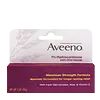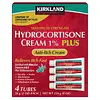What's inside
What's inside
 Key Ingredients
Key Ingredients

 Benefits
Benefits

 Concerns
Concerns

 Ingredients Side-by-side
Ingredients Side-by-side

Water
Skin ConditioningCetearyl Alcohol
EmollientGlycerin
HumectantCeteareth-20
CleansingIsopropyl Myristate
EmollientCyclopentasiloxane
EmollientAvena Sativa Kernel Flour
AbrasiveBenzyl Alcohol
PerfumingCetyl Palmitate
EmollientIsostearyl Neopentanoate
EmollientCitric Acid
BufferingDimethicone/Vinyltrimethylsiloxysilicate Crosspolymer
Potassium Lactate
BufferingDimethyl Mea
BufferingPEG-40 Stearate
EmulsifyingMethylparaben
PreservativeAvena Sativa Kernel Oil
Skin ConditioningTocopheryl Acetate
AntioxidantAloe Barbadensis Leaf Juice
Skin ConditioningChrysanthemum Parthenium Flower Extract
Skin ConditioningAvena Sativa Kernel Extract
AbrasiveSodium Hydroxide
BufferingWater, Cetearyl Alcohol, Glycerin, Ceteareth-20, Isopropyl Myristate, Cyclopentasiloxane, Avena Sativa Kernel Flour, Benzyl Alcohol, Cetyl Palmitate, Isostearyl Neopentanoate, Citric Acid, Dimethicone/Vinyltrimethylsiloxysilicate Crosspolymer, Potassium Lactate, Dimethyl Mea, PEG-40 Stearate, Methylparaben, Avena Sativa Kernel Oil, Tocopheryl Acetate, Aloe Barbadensis Leaf Juice, Chrysanthemum Parthenium Flower Extract, Avena Sativa Kernel Extract, Sodium Hydroxide
Hydrocortisone 1%
Aloe Barbadensis Leaf Juice
Skin ConditioningAluminum Sulfate
AstringentCalcium Acetate
MaskingCetearyl Alcohol
EmollientCetyl Alcohol
EmollientCholecalciferol
Dextrin
AbsorbentGlycerin
HumectantIsopropyl Palmitate
EmollientParaffinum Liquidum
EmollientMaltodextrin
AbsorbentMethylparaben
PreservativePropylene Glycol
HumectantPropylparaben
PreservativeWater
Skin ConditioningRetinyl Palmitate
Skin ConditioningSodium Cetearyl Sulfate
CleansingSodium Lauryl Sulfate
CleansingTocopherol
AntioxidantPetrolatum
EmollientPalau White Clay
HumectantZea Mays Oil
EmulsifyingHydrocortisone 1%, Aloe Barbadensis Leaf Juice, Aluminum Sulfate, Calcium Acetate, Cetearyl Alcohol, Cetyl Alcohol, Cholecalciferol, Dextrin, Glycerin, Isopropyl Palmitate, Paraffinum Liquidum, Maltodextrin, Methylparaben, Propylene Glycol, Propylparaben, Water, Retinyl Palmitate, Sodium Cetearyl Sulfate, Sodium Lauryl Sulfate, Tocopherol, Petrolatum, Palau White Clay, Zea Mays Oil
Ingredients Explained
These ingredients are found in both products.
Ingredients higher up in an ingredient list are typically present in a larger amount.
Aloe Barbadensis Leaf Juice comes from leaves of the aloe plant. Aloe Barbadensis Leaf Juice is best known for helping to soothe sunburns. It is also anti-inflammatory, moisturizing, antiseptic, and can help heal wounds.
Aloe is packed with good stuff including Vitamins A, C, and E. These vitamins are antioxidants, which help fight free-radicals and the damage they may cause. Free-radicals are molecules that may damage your skin cells, such as pollution.
Aloe Barbadensis Leaf Juice also contains sugars. These sugars come in the form of monosaccharides and polysaccharides, folic acid, and choline. These sugars are able to help bind moisture to skin.
It also contains minerals such as calcium, 12 anthraquinones, fatty acids, amino acids, and Vitamin B12.
Learn more about Aloe Barbadensis Leaf JuiceCetearyl alcohol is a mixture of two fatty alcohols: cetyl alcohol and stearyl alcohol. It is mainly used as an emulsifier. Emulsifiers help prevent the separation of oils and products. Due to its composition, it can also be used to thicken a product or help create foam.
Cetearyl alcohol is an emollient. Emollients help soothe and hydrate the skin by trapping moisture.
Studies show Cetearyl alcohol is non-toxic and non-irritating. The FDA allows products labeled "alcohol-free" to have fatty alcohols.
This ingredient is usually derived from plant oils such as palm, vegetable, or coconut oils. There is debate on whether this ingredient will cause acne.
Due to the fatty acid base, this ingredient may not be Malassezia folliculitis safe.
Learn more about Cetearyl AlcoholGlycerin is already naturally found in your skin. It helps moisturize and protect your skin.
A study from 2016 found glycerin to be more effective as a humectant than AHAs and hyaluronic acid.
As a humectant, it helps the skin stay hydrated by pulling moisture to your skin. The low molecular weight of glycerin allows it to pull moisture into the deeper layers of your skin.
Hydrated skin improves your skin barrier; Your skin barrier helps protect against irritants and bacteria.
Glycerin has also been found to have antimicrobial and antiviral properties. Due to these properties, glycerin is often used in wound and burn treatments.
In cosmetics, glycerin is usually derived from plants such as soybean or palm. However, it can also be sourced from animals, such as tallow or animal fat.
This ingredient is organic, colorless, odorless, and non-toxic.
Glycerin is the name for this ingredient in American English. British English uses Glycerol/Glycerine.
Learn more about GlycerinMethylparaben is a preservative and is a paraben. It is used to prevent the growth of fungus, mold, and other harmful bacteria. Parabens are chemicals used as preservatives in both cosmetics and food.
Methylparaben can be synthetically created. It can also be found naturally in some fruits, such as blueberries.
Oftentimes, Methylparaben is combined with other parabens to help increase the shelf life.
The safety of Methylparaben is currently being studied. While ongoing studies are looking into the safety of parabens, the results have been very mixed. Some studies have not found Methylparaben to be harmful.
Learn more about MethylparabenWater. It's the most common cosmetic ingredient of all. You'll usually see it at the top of ingredient lists, meaning that it makes up the largest part of the product.
So why is it so popular? Water most often acts as a solvent - this means that it helps dissolve other ingredients into the formulation.
You'll also recognize water as that liquid we all need to stay alive. If you see this, drink a glass of water. Stay hydrated!
Learn more about Water